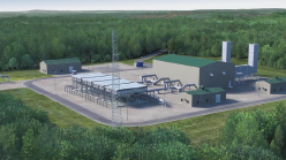WASHINGTON—The United States and Canada will require annual average midstream natural gas investment of $8.2 billion per year, or $205.2 billion (real 2010$) total, over the nearly 25-year period from 2011 to 2035 to accommodate new gas supplies, particularly from the prolific shale gas plays, and growing demand for gas in the power-generation sector, a new study finds. The capital investment requirement includes mainlines, laterals, processing, storage, compression and gathering lines.
The report, North American Natural Gas Midstream Infrastructure through 2035: A Secure Energy Future, conducted by ICF International on behalf of the INGAA Foundation updates a 2009 infrastructure report to reflect the dynamic changes in the natural gas industry in recent years.
“This report shows a vibrant natural gas market in the future, and it also demonstrates the need for additional midstream infrastructure to support it,” said INGAA Foundation President Don Santa. “The good news is that the natural gas industry has a proven track record of constructing and financing this level of infrastructure.”
Santa, also president and CEO of the Interstate Natural Gas Association of America, noted that interstate pipeline expenditures alone met or exceeded $8 billion per year in three of the years between 2006 and 2010, according to Federal Energy Regulatory Commission data. “This is a strong indication that the industry can and will be able to meet the nation’s gas infrastructure needs,” Santa said.
New infrastructure will be required to move natural gas from regions where production is expected to grow and to areas where demand is expected to increase. Not all areas will require new gas pipeline infrastructure, but many areas (even those that have a large amount of existing pipeline capacity) may require new investment to connect new supplies to markets. In recent years, natural gas producers and marketers have been the principal shippers on these new “supply push” pipelines. These “anchor shippers” have been willing to commit to the long-term, firm contracts for natural gas transportation service that provide the financial basis for moving forward with these projects. Going forward, producers should continue to be motivated to ensure outlets for their gas supplies via pipelines. Abundant and geographically diverse shale gas contributes to a competitive natural gas market.
The report’s reference case projects real natural gas prices that rise from $4 to between $6 and $7 per MMBtu (2010$) by 2021 through the end of the study period. It also assumes U.S. population growth at an average rate of about one percent per year and U.S. Gross Domestic Product growth at an average 2.8 percent per year. Electric load is assumed to increase at an average 1.3 percent per year, while oil prices average about $80 per barrel in real terms.
Natural gas consumption in the U.S. and Canada is projected to increase by an average 1.6 percent per year through 2035. Total natural gas use across all sectors is projected to rise to about 109 Bcfd in 2035. Incremental demand growth between 2010 and 2035 is 35 Bcfd, of which 26 Bcfd or 75 percent occurs in the power sector. From a newly projected natural gas resource base of almost 4,000 Tcf, U.S. and Canadian natural gas supplies are projected to grow by 38 Bcfd from about 75 Bcfd in 2010 to about 113 Bcfd in 2035, adequate to meet expanded demand projections in 2035. Unconventional natural gas supplies account for all of the incremental supply as production from conventional areas declines. Unconventional supplies (shale, coal bed methane and tight gas plays) will account for approximately two-thirds of the total gas supply mix in 2035.
The study also assumes that announced near-term midstream pipeline infrastructure projects are completed. Unplanned projects are included in the projection when the market signals need of capacity. Projections for natural gas liquids and oil infrastructure have been included in the study because natural gas is often co-produced with these hydrocarbons. The upstream sector builds gathering and gas processing infrastructure as needed to support supply development. This infrastructure is financed as part of upstream project development.
The study can be found here.






